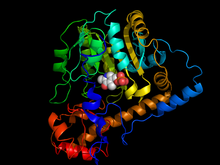Transaminase
| Aminotransferase | |||||||||
|---|---|---|---|---|---|---|---|---|---|
 Aspartate transaminase from E. coli with Pyridoxal 5' Phosphate cofactor | |||||||||
| Identifiers | |||||||||
| Symbol | Aminotransferase | ||||||||
| Pfam | PF00155 | ||||||||
| InterPro | IPR004839 | ||||||||
| Membranome | 273 | ||||||||
| |||||||||
Transaminases or aminotransferases are enzymes that catalyze a transamination reaction between an amino acid and an α-keto acid. They are important in the synthesis of amino acids, which form proteins.
Function and mechanism
An amino acid contains an amino (NH2) group. A keto acid contains a keto (=O) group. In transamination, the NH2 group on one molecule is exchanged with the =O group on the other molecule. The amino acid becomes a keto acid, and the keto acid becomes an amino acid.[citation needed]
Transaminases require the coenzyme pyridoxal phosphate, which is converted into pyridoxamine in the first half-reaction, when an amino acid is converted into a keto acid. Enzyme-bound pyridoxamine in turn reacts with pyruvate, oxaloacetate, or alpha-ketoglutarate, giving alanine, aspartic acid, or glutamic acid, respectively. Many transamination reactions occur in tissues, catalysed by transaminases specific for a particular amino/keto acid pair. The reactions are readily reversible, the direction being determined by which of the reactants are in excess. This reversibility can be exploited for synthetic chemistry applications to achieve the synthesis of valuable chiral amines. The specific enzymes are named from one of the reactant pairs, for example; the reaction between glutamic acid and pyruvic acid to make alpha ketoglutaric acid and alanine is called alanine transaminase and was originally called glutamic-pyruvic transaminase or GPT for short.[1]
Tissue transaminase activities can be investigated by incubating a homogenate with various amino/keto acid pairs. Transamination is demonstrated if the corresponding new amino acid and keto acid are formed, as revealed by paper chromatography. Reversibility is demonstrated by using the complementary keto/amino acid pair as starting reactants. After chromatogram has been taken out of the solvent the chromatogram is then treated with ninhydrin to locate the spots.[2].

Amino acid metabolism in animals
Animals must metabolize proteins to amino acids, at the expense of muscle tissue, when blood sugar is low. The preference of liver transaminases for oxaloacetate or alpha-ketoglutarate plays a key role in funneling nitrogen from amino acid metabolism to aspartate and glutamate for conversion to urea for excretion of nitrogen. In similar manner, in muscles the use of pyruvate for transamination gives alanine, which is carried by the bloodstream to the liver (the overall reaction being termed glucose-alanine cycle). Here other transaminases regenerate pyruvate, which provides a valuable precursor for gluconeogenesis. This alanine cycle is analogous to the Cori cycle, which allows anaerobic metabolism by muscles.[citation needed]
Diagnostic uses
The transaminase enzymes are important in the production of various amino acids, and measuring the concentrations of various transaminases in the blood is important in the diagnosing and tracking many diseases.[citation needed] For example, the presence of elevated transaminases can be an indicator of liver and cardiac damage. Two important transaminase enzymes are aspartate transaminase (AST), also known as serum glutamic oxaloacetic transaminase (SGOT); and alanine transaminase (ALT), also called alanine aminotransferase (ALAT) or serum glutamate-pyruvate transaminase (SGPT). These transaminases were discovered in 1954[1][3][4] and their clinical importance was described in 1955.[5][6][7][8]
See also
- Valproic acid - a GABA transaminase inhibitor
References
- ^ a b Karmen A, Wroblewski F, Ladue JS (January 1955). "Transaminase activity in human blood". The Journal of Clinical Investigation. 34 (1): 126–31. doi:10.1172/jci103055. PMC 438594. PMID 13221663.
- ^ Tulpule, P. G.; Patwardhan, V. N. (April 1952). "Application of Paper Chromatography to the Study of the Transaminase System". Nature. 169 (4303): 671–671. doi:10.1038/169671a0. ISSN 1476-4687.
- ^ Karmen A (January 1955). "A note on the spectrometric assay of glutamic-oxalacetic transaminase in human blood serum". The Journal of Clinical Investigation. 34 (1): 131–3. doi:10.1172/JCI103055. PMC 438594. PMID 13221664.
- ^ Ladue JS, Wroblewski F, Karmen A (September 1954). "Serum glutamic oxaloacetic transaminase activity in human acute transmural myocardial infarction". Science. 120 (3117): 497–9. Bibcode:1954Sci...120..497L. doi:10.1126/science.120.3117.497. PMID 13195683.
- ^ "Biblioteca Nazionale di Napoli. News: Serata in onore di Mario Coltorti e Giuseppe Giusti". vecchiosito.bnnonline.it. Retrieved 2017-09-10.
- ^ "E' morto il prof. Coltorti: scoprì le transaminasi". notizie-segreteria-liver-pool.blogspot.it. Retrieved 2017-09-10.
- ^ "Campania su Coltorti". www.istitutobioetica.org. Retrieved 2017-09-10.
- ^ MonrifNet (3 January 2009). "Il Resto Del Carlino - Macerata - E' morto Mario Coltorti: scoprì la transaminasi". www.ilrestodelcarlino.it (in Italian). Retrieved 2017-09-10.
Further reading
- Ghany M, Hoofnagle JH (2005). "Approach to the Patient With Liver Disease". In Kasper DL, Fauci AS, Longo DL, Braunwald E, Hauser SL, Jameson JL (eds.). Harrison's Principles of Internal Medicine (16th ed.). New York: McGraw-Hill. pp. 1814–5.
- Nelson DL, Cox MM (2000). Lehninger Principles of Biochemistry (3rd ed.). New York: Worth Publishers. pp. 628–31, 634, 828–30.
External links
- Transaminases at the U.S. National Library of Medicine Medical Subject Headings (MeSH)
- CS1 Italian-language sources (it)
- Articles with short description
- Short description is different from Wikidata
- All articles with unsourced statements
- Articles with unsourced statements from March 2022
- Articles with unsourced statements from September 2017
- Articles with BNF identifiers
- Articles with BNFdata identifiers
- Articles with J9U identifiers
- Articles with LCCN identifiers
- Articles with NKC identifiers
- Transferases
- EC 2.6.1
- Hepatology